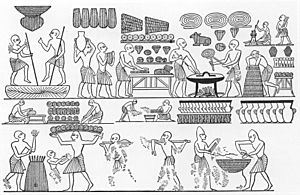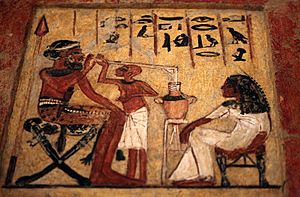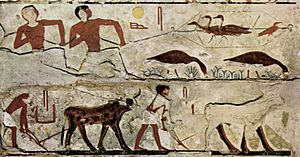Ancient Egyptian cuisine facts for kids

The cuisine of ancient Egypt tells us what people ate and drank over 3,000 years ago! Even after a long time, their food habits stayed pretty much the same until the Greco-Roman period. For both rich and poor Egyptians, the main foods were bread and beer. They often ate these with green onions, other vegetables, and sometimes meat, wild game, or fish.
Contents
Ancient Egyptian Meals and Feasts
Paintings from the Old Kingdom and New Kingdom show us what ancient Egyptian parties, called banquets, looked like. These gatherings usually began in the afternoon. Men and women sat separately unless they were married. Where people sat depended on their social status. Important guests sat on chairs, others on stools, and those with less status sat on the floor.
Before food was served, guests were given basins to wash their hands. Sweet-smelling oils were burned to make the air smell nice or to keep insects away. Guests received lily flowers and flower necklaces. Professional dancers, mostly women, entertained everyone. Musicians played instruments like harps, lutes, drums, tambourines, and clappers.
There was usually a lot of food! People ate whole roasted oxen, ducks, geese, pigeons, and sometimes fish. Dishes often included stews served with lots of bread, fresh vegetables, and fruit. For dessert, there were cakes baked with dates and sweetened with honey. The goddess Hathor was often honored during these feasts.
How Egyptians Cooked Food
Egyptians cooked food in many ways. They would stew, bake, boil, grill, fry, or roast their meals. Spices and herbs were added for flavor. However, spices were expensive because they came from far away. Only wealthy people could afford them.
Meat was often kept fresh by salting it. Dates and raisins could be dried to store them for a long time. Bread and beer were usually made in the same places. This is because the yeast used for bread was also used to make beer. People made them at home or in special bakeries. Any extra food could be sold.
Sweeteners and Oils
Honey was the main way to sweeten food, but it was quite costly. Some honey came from wild bees, and some from bees kept in pottery hives. A cheaper option for sweetness was dates or carob. There was even an ancient Egyptian picture symbol (a hieroglyph) for a carob pod that meant "sweet" or "pleasant."
Egyptians made oils from lettuce or radish seeds, safflower, ben, balanites, and sesame. Animal fat was also used for cooking. Jars used to store animal fat have been found in many ancient settlements.
Bread: A Daily Staple

Egyptian bread was mostly made from a type of wheat called emmer. It was harder to make flour from emmer wheat than from other kinds. The outer covering (chaff) did not come off easily. It had to be moistened and pounded with a pestle to get the grains out without crushing them. Then, it was dried in the sun, cleaned, sieved, and finally ground on a saddle quern. This type of mill worked by moving a stone back and forth, not in a circle.
Baking Methods Over Time
Baking methods changed over the centuries. In the Old Kingdom, heavy pottery molds were filled with dough and baked in hot embers. During the Middle Kingdom, tall cones were used on square hearths. In the New Kingdom, a new kind of large, open-topped clay oven was used. These ovens were shaped like cylinders and covered in thick mud bricks.
Dough was slapped onto the hot inner wall of the oven. It was then peeled off when it was ready. This is similar to how a tandoor oven is used for flatbreads today. Tombs from the New Kingdom show pictures of bread in many different shapes and sizes. There were loaves shaped like people, fish, animals, and fans. They also had different textures. Sometimes, coriander seeds and dates were added for flavor. We don't know if poor people could afford these flavored breads.
Besides emmer, barley was also grown to make bread and beer. Lily seeds and roots, and tiger nuts were also used. The grit from the grinding stones often mixed into the flour. This caused a lot of tooth decay because it wore down tooth enamel. For those who could afford it, there was also fine dessert bread and cakes made from high-quality flour.
Beer: A Nutritious Drink

In ancient Egypt, beer was a very important part of daily life. It was a main source of nutrition and was consumed every day. Beer was so important that it was even used as a form of payment! Unlike European beer, Egyptian beer was very cloudy and had many solid bits in it. It was very nutritious, almost like a thick soup. It provided important protein, minerals, and vitamins. Beer jars were often used to measure value, and beer was even used in medicine. We don't know much about specific types of beer, but there are mentions of "sweet beer," for example.
How Beer Was Made
Archaeologists have found round vessels with narrow necks from pre-dynastic times. These were used to store fermented beer at places like Hierakonpolis and Abydos. They contain emmer wheat residue that shows signs of gentle heating. This suggests they might have been used for early beer brewing.
Evidence from archaeology shows that beer was made by first baking "beer bread." This was a type of well-leavened, lightly baked bread. It was baked just enough so that the yeast in it was not killed. This bread was then crumbled over a sieve and washed with water in a large pot. The mixture was left to ferment. This "beer bread" is very similar to bouza, a drink still enjoyed in Egypt today. Some people claim that dates or malts were used, but there isn't strong proof.
More recent studies using microscopy on beer residue suggest a different way of brewing. This method did not use bread as an ingredient. One batch of grain was sprouted, which created enzymes. Another batch was cooked in water to release its starch. Then, the two batches were mixed. The enzymes started to break down the starch to make sugar. The mixture was then sieved to remove any husks. Finally, yeast (and probably lactic acid) was added to start the fermentation process, which produced alcohol. This brewing method is still used in some parts of Africa today. Most beers were made from barley, and only a few from emmer wheat. So far, no evidence of added flavorings has been found.
Fruits and Vegetables
Vegetables were eaten with the common bread and beer. The most common ones were long, green scallions and garlic. Both also had uses in medicine. Egyptians also ate lettuce, celery (raw or in stews), certain types of cucumber, and possibly some kinds of Old World gourds and even melons. By the Greco-Roman period, turnips were available, but we are not sure if they were eaten before that time. Various tubers from sedges, including papyrus, were eaten. They could be eaten raw, boiled, roasted, or ground into flour, and they were full of nutrients.
Tiger nuts were used to make a dessert. The dried and ground tubers were mixed with honey. Lily and similar water plants could be eaten raw or made into flour. Both their roots and stems were edible. Many pulses and legumes like peas, beans, lentils, and chickpeas were important sources of protein. At the workers' village in Giza, archaeologists found pottery vessels from the Middle East. These were used to store and transport olive oil as early as the 4th Dynasty.
The most common fruits were dates. There were also figs, grapes (and raisins), dom palm nuts (eaten raw or soaked to make juice), certain types of Mimusops fruit, and nabk berries (jujube or other Ziziphus fruits). Figs were very common because they had a lot of sugar and protein. Dates were either dried or eaten fresh. Dates were sometimes even used to make wine, and poor people used them as sweeteners. Unlike vegetables, which grew all year, fruit was more seasonal. Pomegranates and grapes were often placed in the tombs of the deceased.
Meat, Fowl, and Fish
Meat came from farm animals, wild game, and birds. This included partridge, quail, pigeon, ducks, and geese. Chickens probably arrived in Egypt much later, around the 5th to 4th century BC. No chicken bones have been found from before the Greco-Roman period. The most important animals for meat were cattle, sheep, goats, and pigs. Some people used to think that eating pigs was forbidden because priests linked them to the god Seth.
The Greek historian Herodotus, who lived in the 5th century BC, said that Egyptians did not eat female cows because they were sacred to the goddess Isis. They sacrificed male oxen that were healthy and free of disease. After a ritual burning, they ate the rest of the meat. Sick or diseased male oxen that died were buried in a special way. Their bones were later dug up and placed in a temple. Only the heads of male oxen, which were cut off and "cursed," could be eaten by Greeks living in Egypt, as they were not allowed to eat the sacred sacrifice meat. However, excavations at the Giza workers' village have found evidence of many oxen, sheep, and pigs being butchered. Researchers believe that the workers building the Great Pyramid ate beef every day!
Mutton (sheep meat) and pork were more common, even though Herodotus claimed Egyptians thought pigs were unclean. Birds, both wild and farmed, and fish were available to almost everyone, except the very poorest. Other ways to get protein included legumes, eggs, cheese, and the nutrients found in bread and beer. Mice and hedgehogs were also eaten. A common way to cook a hedgehog was to cover it in clay and bake it. When the clay was cracked open and removed, it pulled the hedgehog's prickly spikes off with it.
Foie gras, a well-known delicacy (a special food) still enjoyed today, was actually invented by the ancient Egyptians. The method of gavage, which means feeding domesticated ducks and geese a lot of food to make their livers bigger, dates back to 2500 BC. This is when Egyptians started raising birds for food.
A book from the 14th century, translated in 2017, even lists 10 recipes for sparrows!
See also
 In Spanish: Alimentación en el Antiguo Egipto para niños
In Spanish: Alimentación en el Antiguo Egipto para niños


